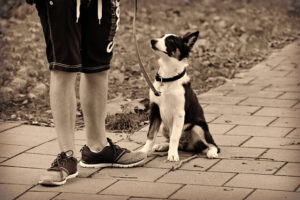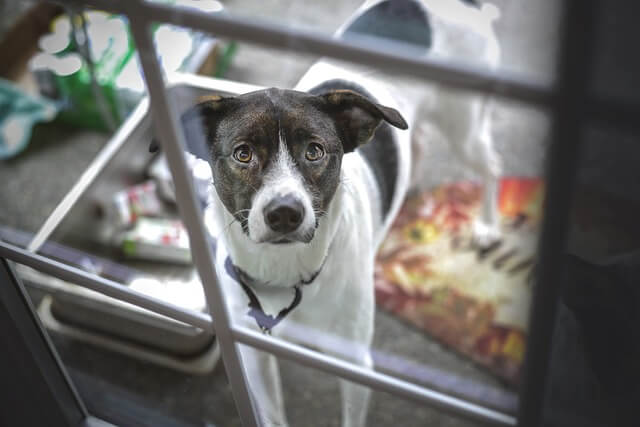Does Your Dog Scratch or Jump Up on Your Doors?
How Can You Protect Your Doors from Scratches When Your Dog Won’t Listen?
and Scratches the Door Every Time it Either Wants to Go Out or it Wants to Come In?
This has always been a problem with our dogs, at least up until a few years ago…and, once in awhile, I have to admit they occasionally forget and jump up on the door or door frame still. But, for the most part, they just don’t bother doing it anymore.
Yes, they behave now, but in the past they sure made our home look terrible. Especially if you have a wooden door, which most people do in their homes. But, even with a steel exterior door the frame is usually still wood…and if your dog is scratching at more than one door it can get expensive to replace them all.
Usually the doors that got the most abuse for us was our back door that we usually let our dogs outside from all the time…
Back then, they’d get excited and jump up on the door every time they even thought it was time to go out! So, although they never really scratched too much at the door, they still tore it all up after awhile by jumping on it.
And it looked Terrible!
Both the door and the frame around it were gouged and scratched looking…something that’s an issue for a few of our doorways since there’s actually two doors to go through, one in the kitchen and one in our porch. They’ll need to be at least fixed up and repainted, along with the door frames…
*btw, I’ll share a video on how to do that at the end of this post.
Ways to Protect Your Door from Scratches
- Teach your Dog not to jump on doors
- Daily Exercise
- Install a scratch or door guard
- Install a doggy door
- Let dog out/in before it gets a chance to scratch the door
Proper Training

A good way to avoid having scratches and claw marks on your doors is to teach your dog that you don’t approve of it jumping or scratching at the doors in your home. Of course, this can take some time and patience on your part to get your dog to learn the behavior you want it to have.
Most dogs scratch at the door either to be let in or out, or they accidentally scratch it up by jumping up on the door in their excitement when they know it’s time to go out or maybe even when they’re greeting you at the door.
Another common reason a dog will scratch at the door is separation anxiety. If your dog is scratching the door to follow you in another room, it may be a sign of separation anxiety.
The topic of separation anxiety is a rather complicated one, which you can read more about on an older post of mine here Calm Dog Separation Anxiety.
A Few Tips on Training Your Dog to Stop Scratching the Door When It’s Time to Go Out
- Stay Calm – don’t make a big deal of letting your dog out
- Say a firm “no” if you dog jumps up on the door or scratches at it
- Use positive reinforcement when your dog is doing what you want
Teach your dog it isn’t that big of a deal to go outside by walking calmly to the door with your dog. If your dog is like ours used to be, acting hyper by jumping and running circles around you as you go to the door don’t make them more excited by using a lot of energy in your voice or actions…such as saying in a high-pitched voice “let’s go out” or even yelling at them to “calm down.”
This just makes them more excited and you’re actually encouraging your dog to be excited every time it goes to the door…
Not what you want, right?
Chances are they already know it’s time to go out if they’re doing this…so, what I’ve done is instead take my sweet time to get to the door. If they’re barking and running around like that, I’ll make them wait by going and doing something else. Once I see they’ve settled down a bit, then I’ll start for the door again.
If they happen to scratch or jump up on the door while we’re waiting, just say a firm “no” once or even rattle a can full of coins or small pebbles…something noisy to get their attention. The important thing is to get their focus off of the door and get it on you…make them learn to watch you and wait for you to tell them what you want them to do.

Once you do, a good way to get them to learn to be calmer when going out the door is to have them sit down first.
Once they sit, give them a reward, such as “good boy or good girl” and a small treat they like. Then go ahead and open the door.
Daily Exercise
Another good idea is to take your dog out for daily walks. It’s not only good for burning off a little energy for your dog, it’s a good excuse to get some exercise yourself. Some dogs need more walking than others, but at least even a 20-30 minute walk is much better than nothing. Plus, it’s a good opportunity to spend some time with your dog, which will make your dog happy.
I’ve found our dogs to behave much better when I’ve taken them for daily walks, although when they were younger, they had a lot more energy…well, so did I, lol! But, even then, once we got back from our walk, they weren’t quite so rambunctious to jump and scratch at the door when being let out a few hours later.
Install a Scratch or Door Guard
Another thing you can do to prevent your doors from the dogs scratching at them, is to install a door guard made of either heavy plastic or vinyl. There are quite a few different brands and sizes to choose from for different types of doors such as a wood or metal door. Some can even be easily removed if you want to take it off when you have company while others may be a bit harder to remove.
A couple of things to consider before choosing a door guard is the type of door you have, whether it’s wood or metal, or maybe even a glass door. The size of your dog may also be a good thing to think about as well since there are door scratch guards especially for larger dogs, I believe. So, you’d want to think about what size you need and where you need it to cover…just the door? Or, both the door and the trim next to it?
If you’d like to know more about these door protectors, check out my recent review on these scratch guards for doors.
Install a doggy door
Another option is to install a doggy door for your dog. Of course, this may not be an option for you if you don’t already have a fenced in yard for your dog to go outside in safely. I certainly wouldn’t recommend a doggy door that will let your dog out loose to run in the neighborhood or out in the street.
But, if you do have a fenced in yard using a doggy door might help quite a bit in preventing your door from looking like it was attacked by a ferocious beast. This way your dog can come and go as it pleases, and won’t be scratching at the door to be let in or out. Plus, you can install a doggy door yourself if you’re so inclined and want to save money, or hire someone to do it for you.
Oh, and if you rent your home, you might want to ask your landlord if they’ll allow you to install a doggy door first…who knows, maybe they’ll even do it for you or at least reimburse some of the cost…never hurts to ask! But, definitely ask your landlord first about it before doing anything.
Let dog out/in before it gets a chance to scratch the door
If your dog scratches at the door to be let out, try to watch your dog for signs that it needs to go out to go potty. Usually ours will let us know that they need to go out by whining, coming up to us and giving us “the stare,” barking, or doing something to get our attention.
However, we usually let them out pretty often during the day when we’re home. At least every three or four hours since ours are all older dogs now. But, when your dog is still a pup, I’d recommend every couple hours at least, as well as about 15-20 minutes after drinking or eating anything, and upon awakening from a nap.
As puppies, they haven’t yet learned how exactly to let you know yet, but they’re learning! They eventually know where they need to go, and that the door needs to open before they can get out, which is why the door often becomes the victim of scratching and pawing if you’re not careful.
One thing I found helpful to keep our puppies from clawing the door is to use a bell hanging off the doorknob, low enough where they’d bump it…if I heard them rattling it around, I knew they were by the door wanting out.
It’s also a good idea to watch your puppy and learn it’s behaviors. Something puppies usually do before having to go potty is they search for a place to go, so if you see your pup sniffing and circling around the area, it probably is needing to go out.
Anyways, there are quite a few ways to keep your home looking nice even if you have a dog or maybe even a few dogs…even those darn doors can look beautiful again!
Got Scratched up Doors? Here’s How You Can Fix Them Yourself…
Doors are rather expensive, and why buy a new one if you can save some money and fix your old door with a bit of caulking, paint, and some elbow grease… watch the video below to find out how.
It’s hard enough keeping it clean looking with dogs in the home, chasing their furballs, and cleaning up mud, grass, or whatever they may drag in along with them.
And yes, it can get so very depressing to see your nice looking door all scratched to bits…
A door that reminds you of doors you see in horror movies with all the gashes and claw marks all over it…yeah, we’ve been there before!
But, it doesn’t have to be that way anymore!
I hope this post has helped you get some ideas on protecting your doors, and even those door frames, don’t forget those!
Does Your Dog Scratch at the Door? What solutions have you tried to stop it from scratching?
I’d love to hear from you, please let me know if you have any questions or comments in the box below, and as always…
Thanks for reading!
Please share this if you found it helpful or know someone that might find this helpful for their dog…I’d appreciate it and our doggies do too!



I think that, if you want to have your doors, furniture or something else to be in a good condition, you must teach your pet from its birth. Am I right?
Hello,
Yes, I’d definitely have to agree with you on that…it does help a lot if your dog is trained on what you expect from it right from birth. We’ve found it’s much easier to train a puppy rather than an older dog not to scratch or chew on the doors or furniture, but even older dogs eventually learn with time and patience.
In the meantime, whether puppies or an older dog, it does help to protect the doors and furniture with some type of scratchguard, as just like kids they don’t always listen at first, depending on how well they learn, and on how their temperament is…it all depends though, even as puppies some learn rather quick not to do something, while others take awhile.
Thank you for stopping in and leaving a comment! It’s great to hear from you and I hope I’ve helped answer your question…and, if you have any other questions about dogs, do let us know. We’d love to hear again from you.
Great article for anyone having issues with there dog scratching the doors. Thankfully we have 3 dogs and none of them scratch at all… although we do give them plenty of exercise and before we moved had a doggy door for them to go in and out as they pleased.. well worth fitting … Thanks again just another reminder of how good our dogs are 🙂
Hi Martin,
Thank you for stopping by and commenting! Yeah, I’m thinking enough exercise and having a doggy door installed certainly has been well worth it in your case…
Great to hear that it works so well, even having three dogs!
I’m thinking we should have installed a doggy door years ago, and probably would have avoided a lot of the scratched up doors we’ve had…but, now, as our dogs are mostly getting older they’re not jumping up as they used to do…it’s pretty rare that they have enough energy to jump up like crazy fools like they did as pups anymore.
Now, they’re the ones often lagging behind during our walks…it used to be the other way around before! They had so much energy! But, then again, we recently adopted another dog, which brings us up to four dogs in the home again…and this one, although she’s older too, she’s full of energy and likes to jump around a lot yet, lol.
So, I guess we’ll see how our doors look in the days ahead!
Anyways, thanks again for commenting, Martin! Your comment here, proves that it goes to show what plenty of exercise can do for our dogs, doesn’t it?
Best wishes ~Sherry
Hi Sherry,
Wow, what a great post. I need to give you an extra thank you for standing by your methods. Dog training tips can be a ‘tin of worms’ as everyman and his dog (sorry couldn’t help it) has their own views on what is and isn’t the correct way to train. As soon as I started to read your article I was reminded of us using the ‘coins in a tin method’ I had decided not to mention it in the comments, just in case you had a barrage of complaints about what is and isn’t acceptable. Good for you. This method helped us with a persistent ‘barker’ every time the doorbell rang. We managed to get it down to just a couple of barks, which was perfect,alerting us to the door and whoever was calling,that we had a dog.
Positive reinforcement is something I really struggled with but I know it does work and is a proven method. My area of struggle, was using it was during ‘recall’ After it had taken five minutes of shouting and yelling to get my loyal friend to return, the last thing I wanted to do was to say well done. We get there in the end.
You are spot on about ‘dragging it out’ as it were. They are sometimes too keenly tuned in to whatever might be about to happen. My wife even struggles now,when she puts her coat on. They get up and start prancing around,ears up, the odd whinney. Many times I have carried on in the kitchen pretending to do something else until their enthusiasm had wavered.
So a wonderful review, with some really useful tips and great advice. We all find, or try to,what works for us and our pets. It’s not one size fits all. The more things we can try, the more likely we are to have success.
Thanks again.
Hi Twack Romero,
Thank you so much for stopping by and commenting here! Yes, I have to say I agree that dog training tips can sure be a “tin of worms” and each and everyone has their own views and opinions on what’s correct or not. But, I always figure to each their own, what works for some might not work for others.
Anyways, no worries! If people want to complain, then let them, but I’ll still tell them what worked for me, lol…plus, using the “coins in a tin” to distract them long enough to stop what they’re doing, (uh, the dogs I mean) hurts no one…not the dogs, and not me either. If someone else has a “better” idea than that, I’d love to know it, since it might work for some dogs. You just never know…
I’ve seen some very foolish, and I’d have to say ignorant people over the years, that actually hit their dog to get them to stop what they’re doing and it never ends well…their dog either ended up scared of everything and/or had aggression issues, and ended up nearly biting their owner…
And, I can’t say I’d blame the dog at all. I would too, if someone went and hit me for everything…well, maybe not bite them, but I just might eventually hit them back, lol.
So, to me something like the “coins in a tin” method and positive reinforcement is a much better way to get your dog to listen. It has actually worked with all the dogs we’ve had so far. Although we’ve had many dogs over the years, and they’ve all had their own personalities as well.
I can say too that recall is often a trying time to say the least, lol…I certainly hear ya on that one! It’s not the easiest thing to say “well done” or “good dog” after 5 minutes of shouting and yelling (while cursing under your breath) for them to come back…But, as you said, we do get there in the end, and I have to say to you, a big Thank You and congratulations at sticking it out!
One thing I’ve learned to do, that sometimes works to get them to come back quicker, is to pretend I’m leaving and start going the other way. Or, start going into the house even…as long as I could get their attention long enough to see me walking away, it worked to get their butts back in a hurry!
Wow, I see you pay quite a bit of attention to what your dogs are acting like…which I find awesome! A lot of people don’t really notice the change in their dogs behavior as they’re too busy making a big deal of leaving the house and getting their dog even more wound up. That’s a great idea to start doing something, or pretend to be, while your wife is getting her coat on…distractions and diversions are a great way to trick them into thinking there’s nothing going on and you’re not going anywhere.
How many dogs do you have, Twack? They’re some lucky dogs I believe! It sounds like you and your wife try your best at figuring out what makes them happy, and what works to keep them in line as well, in the best way you can, and I find that awesome! It’s exactly what myself and my family try our best to do as well.
Thanks again for such a wonderful comment! I hope to hear from you again sometime!
Best wishes to all of you! ~Sherry
This is an incredible post. This article is well appreciated because i am a dog lover and i saybits a must for all pet lovers to read. It seems proper training is the key and the best way to go about that is to get professionals to train them up; after which we can now implement daily exercise.
Thanks for this wonderful eye opener article. Its well appreciated
Hi Ola,
Thank you for stopping by and commenting! Yes, proper training works wonders as does daily exercise for our dogs…I’ve found those to be the key to keeping the dogs well behaved and our house from falling apart, lol.
Although I’ve never really brought ours to a professional trainer, I did spend a lot of time learning how to train them myself from doing a lot of research in books, videos, and online training courses from professional dog trainers. However, some dogs might need a professional to also step in if they’re behavior is extremely beyond the owner’s control or knowledge.
Anyways, I might also add there are times that dogs get excited no matter what, especially if they’re still learning or they’re a younger dog, the use of scratch guards on the door help to protect it quite a bit as well. I’d definitely use them if I were renting a home or apartment, just in case!
Thank you again for stopping by and I hope to hear from you again sometime, Ola! If you ever have any questions, let me know and I’ll be happy to answer them as best I can.
Best wishes ~Sherry